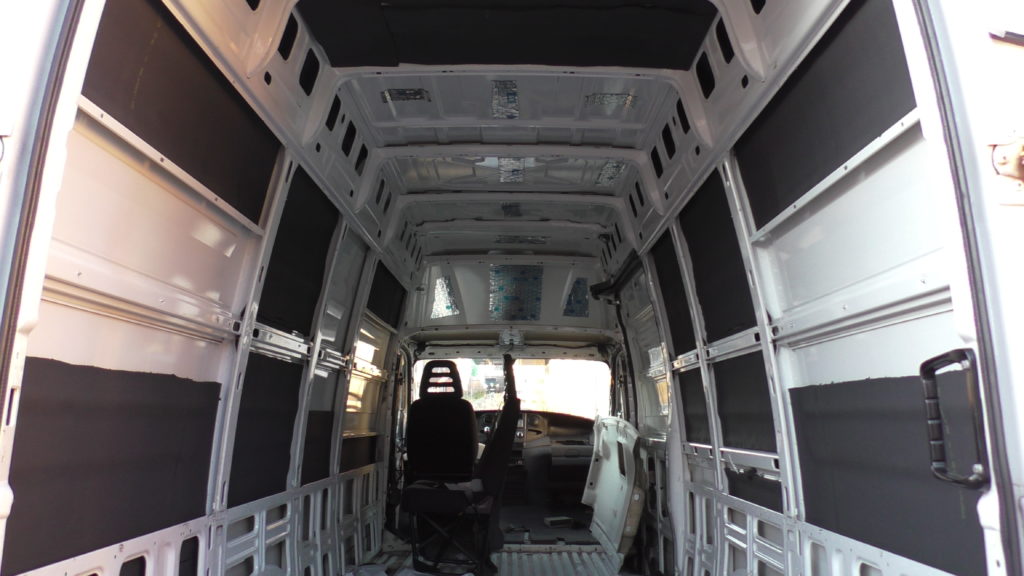
Chapter 6: Armaflex XG for Camper van Insulation
After we gave the Iveco Daily a better insulation against sound with Alubutyl, we are going to start today with the insulation against heat and cold (retrospectively, the use of Armaflex makes the application of Alubutyl (nearly) superfluous… A learning for the future). After careful consideration we decided on self-adhesive Armacell Armaflex XG mats (19mm).
In the linked article you can find out why we chose Armaflex XG in the camper and not ACE or AF.

Which insulation material? NoGos?
You can make some mistakes when choosing the insulation material. In addition, the search is made more difficult by the fact that there are few reports of real mistakes. Instead, every owner of a self-construction is very convinced of his own insulation variant. Years later, we will not typically not hear of damages that occured. Therefore we do not want to talk critically about any other variants, as we simply do not know…
However, an absolute NoGo when insulating campers is the use of Armaflex ACE (I don’t link it for good reason 🙂 ). This is a cheaper insulation material from Armacell. However, ACE has a strong smell and even after weeks the smell is still clearly noticeable. So keep your hands off Armaflex ACE, even if the slightly lower price seems tempting! The additional costs of approx. 10€ more for Armaflex XG* (6 square meters each) are really worth it!
To answer why we did we choose Armaflex XG: Insulation with mineral wool, polystyrene and a vapour barrier was a good alternative. In the end we decided on the significantly more expensive Armaflex. For us this has the advantage that after the insulation is completewe still have the option of pulling cables and pipes through spars and can put everything in place later on during the finishing work. With other insulation materials, a vapor barrier is typically needed. We would then either need to plan everything in advance or would have to open the barrier if we had spontaneously changed cable positioning. Since this is our first extension, it is certainly safer to be able to change all cables and pipes in the Iveco as long as we do the camper conversion.
Insulating the Iveco Daily
So we decided on Armaflex XG, to be precise, 19mm thick self-adhesive mats. We decided to order Armaflex XG on ebay*, which was the cheapest option including shipping. The shipping costs are significant for insulation material, so it is better to look twice and recalculate.
The material is very easy to process. Because vertical and horizontal lines are drawn on the back (adhesive foil), you can cut the foil straight and prepare suitable pieces for the individual segments in the camper. With some preparation you can cut out suitable pieces for all large areas in the camper in 2-3 hours. Of course the pieces do not always fit perfectly, but with small remnants you can easily fill the last spots.
I will upload a video in timelapse of the entire insulation work as soon as the insulation is completely finished.
How to fill cracks and small areas with Armaflex
After 5-6 hours most of the surfaces on the walls were covered with Armaflex. Unfortunately, the Iveco Daily is equipped with all kinds of bracing in the lower area. This makes it impossible to attach perfectly cut mats.

After some trial and error we found a good solution for us to attach smaller sheets of Armaflex. We cut long stripes that fit the length of the respective area, which we then pull under the bracing. Then we hold the strip correctly at the top edge, loosen the adhesive film at one corner of the Armaflex XG and then gradually stick the strip to the sheet.
A short summary of how we attached the insulation in these tight places can be found below:
Double insulation in the roof?
Finally, the roof must be insulated. For this I decided to use a double layer of Armaflex. Why? Warm air rises up and should condensation occur in the camper van, it is best, if it occurs on the sides. There, I am confident that if a drop of water should form on a spar or a poorly insulated spot on the wall, it can run down to the floor and will land in a lateral bracing at floor level. There the water can evaporate well in the medium term.
If there is condensation on the ceiling, I fear that the water drop will not run along the wall. Instead, it will drip onto the ceiling paneling from the inside. This is not only poorly ventilated, but also made of wood, so I see potential for mold here. Therefore we insulate the ceiling with 38mm Armaflex.
Tthis page is not a guide! If you have good reasons against our ceiling insulation, we are happy to receive constructive feedback!